Social and economic analysis
The findings of larger studies carried out by the UK Marine Monitoring and Assessment Strategy Community Productive Seas Evidence Group in 2019 was based on Office for National Statistics (ONS) data from 2015.
The ONS has yet to update these data sets, meaning we are unable to provide a meaningful comparison for the UK Marine Strategy Part One update at this time. The UK governments recognise the importance of understanding the socioeconomic impacts and implications of our relevant policies and significant progress has been made in this field since 2015. Other sources of data are now available but because these come from different sources and use different collection protocols, direct comparison with ONS data is not possible. We hope to provide a summary of the updated data from the ONS when available.
